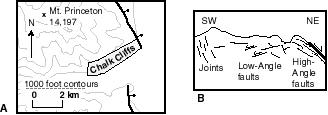
THE CHALK CLIFFS, NATHROP, COLORADO: A NATURAL CROSS-SECTION OF A SEGMENT BOUNDARY IN A NORMAL FAULT SYSTEM MILLER, Martin G., Dept. of Geological Sciences, University of Oregon, Eugene, OR 97403; HOOPER, Robert L., Dept. of Geology, University of Wisconsin--Eau Claire, Eau Claire, WI 54702. The Chalk Cliffs, composed of Tertiary quartz monzonite, occupy a right-stepping jog of approximately 1.25 km in the Holocene Sawatch Range fault system (Fig. A). Their internal deformation and extreme hydrothermal alteration plus local relief of >1.5 km on the present fault-bounded rangefront suggest that the jog persists vertically for at least several km. Therefore, it is likely that this jog bounds two distinct segments of the fault system. The cliffs trend NE, roughly perpendicular to the bounding faults. Fault and fracture orientations in the cliffs vary according to location (Fig. B). On the NE, closely spaced faults dip about 55° eastward, sub-parallel to the range-frontal fault, and exhibit evidence for down-to-the-east (normal) slip. To the southwest, low-angle west-dipping normal faults, accompanied by low-angle east- and west-dipping extension fractures dominate. The low- and high-angle structures show mutually cross-cutting relations. Both sets show evidence for recurrent activity as breccias with mineralized clasts. Farther west, outside the segment boundary, the cliffs display abundant vertical and sheeting joints.

Hydrothermal alteration occurs along fractures and faults. Dominant minerals include chlorite and laumontite but epidote and calcite are also abundant. Fine-grained silica occurs within fault zones. laumontite-filled fractures typically postdate those filled with chlorite. Ongoing hydrothermal activity is evident at the adjacent Hortense and Mt. Princeton Hot Springs.